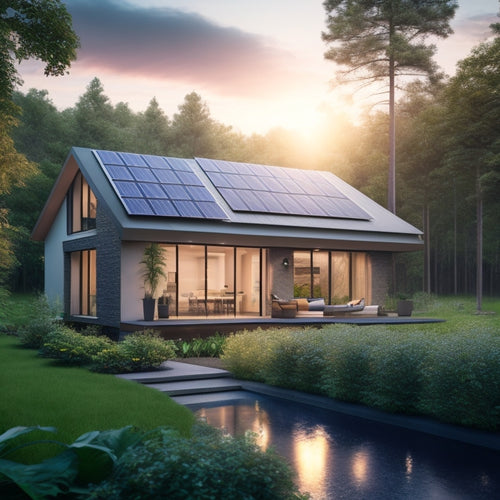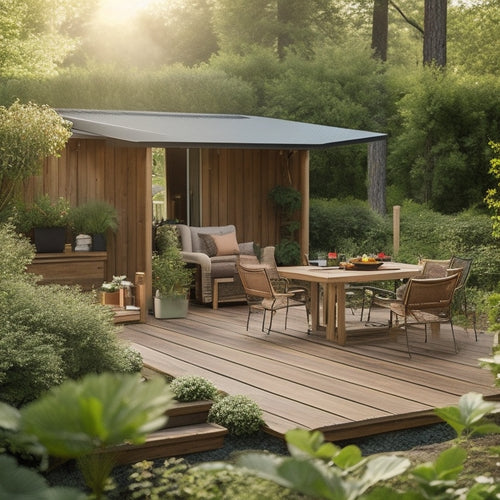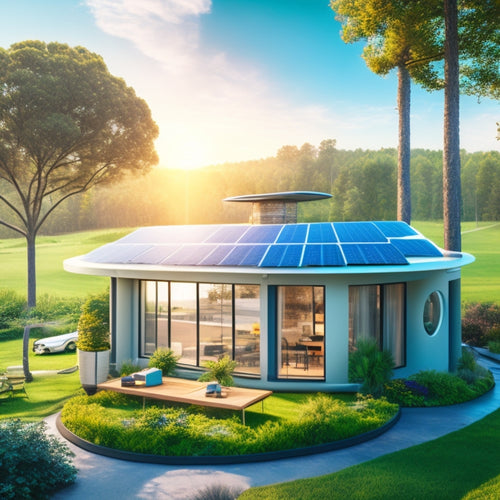
Why Consider Wind Power for Your Home?
Share
By considering wind power for your home, you can tap into a clean, reliable, and cost-effective source of energy, reducing your reliance on fossil fuels and mitigating your carbon footprint. Wind turbines can be installed on your property, generating electricity at a lower cost than traditional sources. You'll need to assess your home's wind potential, understand installation costs and incentives, and evaluate energy generation capacity. Additionally, you'll want to analyze noise and visual impact, review local zoning regulations, and consider maintenance requirements. As you investigate the benefits of wind power, you'll uncover the unique advantages it offers, and how it can be a smart choice for your energy needs - with many more details to reveal.
Key Takeaways
- Wind power can provide a consistent and renewable energy source, reducing reliance on fossil fuels and mitigating climate change.
- Conducting a wind resource assessment helps determine the site's suitability and energy generation potential, ensuring accurate energy estimates.
- Federal and state incentives, such as tax credits and grants, can significantly offset the installation costs of a wind turbine system.
- Wind energy is cost-competitive with solar, offering a higher capacity factor and more consistent energy supply, making it a viable alternative.
- Integrating wind power with energy storage systems can enhance grid resiliency and provide a reliable source of electricity for your home.
Assessing Your Home's Wind Potential
Before investing in a wind power system, take stock of your home's wind potential to determine if utilizing wind energy is a viable option. Conducting a wind resource assessment will help you evaluate your site's suitability for wind energy generation. This assessment involves measuring wind speed, direction, and turbulence at your location.
You'll need to take into account site evaluation criteria such as wind shear, turbulence intensity, and air density to determine the quality of your wind resource. Additionally, it's crucial to investigate alternative fuel solutions and take into account the benefits of hybrid electric solutions, which can improve fuel efficiency and reduce emissions.
Understanding Turbine Installation Costs
Having determined your site's wind potential, you're now ready to investigate the financial aspects of installing a wind power system.
Turbine installation costs vary depending on the size and type of turbine, as well as local labor and material costs. On average, a residential wind turbine can cost between $2,000 and $10,000 per kilowatt of capacity. For a typical home system, the total cost can range from $15,000 to $50,000 or more.
Federal incentives, such as tax credits and grants, can help offset these costs, making renewable energy a more accessible option for homeowners. Fortunately, turbine financing options are available to help offset the upfront costs.
Installation timelines typically range from a few weeks to several months, depending on the complexity of the project and local permits.
Carefully evaluating these costs and timelines will help you make an informed decision about investing in wind power for your home.
Evaluating Energy Generation Capacity
You'll need to assess your site's wind speed to determine its energy generation potential, as it's a critical factor in selecting the right turbine size and capacity for your home.
Turbine capacity, measured in kilowatts (kW), directly affects the amount of electricity it can produce.
For instance, integrating energy storage systems can enhance grid resiliency and optimize energy efficiency, making it essential to evaluate this factor when assessing your energy generation needs.
Site Wind Speed Matters
Your turbine's energy generation capacity hinges on an essential factor: the wind speed at your site. A thorough site assessment is necessary to determine the average wind speed, which directly impacts the amount of electricity your turbine can produce. Wind speed measurement is a vital step in this process, as it helps you understand the energy potential of your location.
| Wind Speed (m/s) | Energy Production (kWh) | Feasibility |
|---|---|---|
| 5-6 | 1,000-2,000 | Marginal |
| 7-8 | 2,000-4,000 | Good |
| 9-10 | 4,000-6,000 | Excellent |
Using site assessment techniques, you can identify the best location for your turbine and optimize its performance. By accurately measuring wind speed, you can guarantee a reliable and efficient energy source for your home.
Turbine Size and Capacity
Selecting the right turbine size and capacity is essential to utilizing the maximum energy potential from the wind at your site.
You'll want to choose a turbine that's optimized for your location's wind speed and direction. Different turbine types are designed for specific wind speed ranges, so it's vital to select the right one for your site.
Efficiency ratings also play a significant role, as they determine how much of the wind's energy is converted into electricity. Look for turbines with high efficiency ratings to maximize your energy production.
Energy Production Estimates
By the time you've chosen the right turbine size and capacity for your site, the next step is to estimate how much energy it will generate. This is vital in determining the energy efficiency of your wind power system. You'll want to take into account factors like wind speed, turbine efficiency, and grid integration to get an accurate estimate.
| Turbine Capacity (kW) | Average Wind Speed (mph) | Estimated Energy Production (kWh/month) |
|---|---|---|
| 2.5 | 7-10 | 300-500 |
| 5.0 | 10-12 | 800-1200 |
| 10.0 | 12-15 | 2000-3000 |
Keep in mind that these are rough estimates and actual energy production may vary. It's important to consult with a wind energy expert to get a more precise calculation customized to your specific site conditions.
Analyzing Noise and Visual Impact
You'll need to take into account the noise pollution levels generated by your wind turbine, as well as the visual aesthetics that matter to you and your neighbors.
The distance and placement of your turbine from your home and surrounding structures will greatly impact both of these factors.
Land acquisition and site preparation costs electrical infrastructure upgrades are also vital considerations when setting up a wind turbine.
Noise Pollution Levels
Wind turbines, a common sight in modern renewable energy environments, can generate a notable amount of noise. As you consider installing a wind turbine on your property, it's crucial to understand the potential noise pollution levels. You may wonder how this will impact your daily life and that of your neighbors.
In addition, just as electric garbage trucks greatly reduce greenhouse gas emissions and air pollution Electric Garbage Trucks Pave Greener Future Ahead, wind turbines can contribute to a cleaner environment for future generations. Community perceptions of noise levels vary, but generally, turbines are considered acceptable if the sound level is around 35-40 decibels.
To mitigate sound concerns, turbine manufacturers and installers often implement sound mitigation strategies, such as optimizing turbine placement and using noise-reducing technologies. By understanding noise pollution levels and sound mitigation techniques, you can make an informed decision about wind power for your home.
Visual Aesthetics Matters
The silhouette of a wind turbine can be a striking addition to your property's surroundings, but it's essential to reflect on the visual impact on your daily life and that of your neighbors.
You'll want to take into account turbine design and how it integrates with your property's aesthetic. A well-designed turbine can blend seamlessly into the environment, while a poorly designed one can be an eyesore.
Think about the color, shape, and size of the turbine and how it will affect your view. Consider consulting with a professional to guarantee aesthetic integration and minimize visual disruption.
Distance and Placement
Positioning a wind turbine at an ideal distance and location on your property is essential to minimize its visual and auditory impact. You'll want to take into account factors like turbine orientation, site accessibility, and nearby obstacles that could interfere with airflow or create noise.
| Consideration | Guideline |
|---|---|
| Minimum distance from residence | 300-500 feet |
| Turbine height above surrounding trees | 20-30 feet |
| Distance from property lines | 50-100 feet |
| Site accessibility for maintenance | Clear path 10-15 feet wide |
| Obstacles within 500 feet | Avoid trees, buildings, and power lines |
Reviewing Local Zoning Regulations
Before installing a residential wind turbine, you'll need to verify it complies with local zoning regulations, which can vary greatly from one region to another.
These regulations dictate the height, size, and placement of wind turbines, guaranteeing they don't obstruct neighboring views or compromise local aesthetics.
You'll need to research local policies and zoning restrictions in your area to ascertain your turbine meets the requirements. This may involve obtaining permits or undergoing a review process.
Don't assume your turbine will be approved – some areas have strict regulations or outright bans on wind turbines.
Considering Maintenance Requirements
You've guaranteed your wind turbine complies with local zoning regulations, now it's time to think about the long-term commitment of owning a residential wind turbine: maintenance.
Regular turbine maintenance is vital to guarantee peak performance, reduce repair frequency, and minimize maintenance costs.
Here are key aspects to reflect on:
-
Service contracts: Consider hiring a professional to perform routine maintenance tasks, such as lubricating moving parts and inspecting components.
-
DIY maintenance: You can perform simple tasks like cleaning the turbine and checking for loose bolts, but be aware of your limitations.
-
Professional inspections: Schedule regular inspections to identify potential issues before they become major problems.
- Component lifespan: Be prepared to replace components as they reach the end of their lifespan, such as blades or bearings, to maintain your turbine's efficiency.
Weighing Incentives and Rebates
One considerable advantage of investing in a residential wind turbine is the availability of incentives and rebates that can help offset the initial cost.
You'll want to examine the federal incentives, such as the Renewable Energy Property Tax Credit, which allows you to claim a credit of 26% of the total cost of your wind turbine.
Additionally, many states offer rebates that can further reduce your out-of-pocket expenses. You can check with your state's energy office or public utility commission to see what programs are available.
Comparing Wind to Other Renewables
As you investigate the world of renewable energy, it's natural to wonder how wind power stacks up against other options.
When comparing wind to other renewables, consider the following:
-
Cost: Wind energy benefits from turbine technology advancements, making it more competitive with solar power regarding cost per kilowatt-hour.
-
Efficiency: Wind turbines can generate power at a capacity factor of 45-50%, outperforming solar panels which typically operate at 20-25%.
-
Land use: Wind farms require considerably less land than solar farms, making them ideal for large-scale energy production.
- Reliability: Wind power can provide a more consistent energy supply than solar power, which is often affected by weather conditions.
Frequently Asked Questions
Can I Install a Wind Turbine in an Urban or Suburban Area?
You can install a wind turbine in an urban or suburban area, but you'll need to check local regulations regarding noise concerns, turbines' proximity to buildings, and permits, ensuring a feasible and compliant installation that respects your neighbors' comfort.
Will My Homeowner's Insurance Cover Wind Turbine Damage?
Like a ship steering through uncharted waters, you're wise to investigate insurance coverage for your wind turbine. Check your policy; some insurers offer specialized coverage for turbine installation, while others may require additional riders or separate insurance policies.
Can I Sell Excess Energy Back to the Grid?
You can sell excess energy back to the grid through net metering, earning energy credits that offset your utility bills. After turbine installation, your utility company will provide a special meter to track excess production and credit your account.
How Long Does a Typical Wind Turbine Last?
You can expect a typical wind turbine to last around 20-25 years, with regular turbine maintenance ensuring peak energy efficiency; by doing so, you'll maximize your wind power investment and enjoy years of reliable, clean energy.
Are Wind Turbines Compatible With Solar Panel Systems?
You'll find wind turbines are compatible with solar panel systems, as both utilize renewable energy. When installing a turbine, you'll need to evaluate turbine installation requirements, but the wind energy benefits will be worth it, enhancing your energy independence.
Related Posts
-

3 Best Eco-Grants for Home Energy Upgrades
You're eligible for various eco-grants that can help you cut down on energy bills and reduce your carbon footprint by...
-

Green Deck Options: Earth-Conscious Choices for Your Home
You're looking for a deck that not only enhances your home's exterior but also aligns with your eco-friendly values. ...
-

Gamify Your Home's Energy Generation and Savings
You're taking the next step in optimizing your home's energy generation and savings by utilizing the power of gamific...


